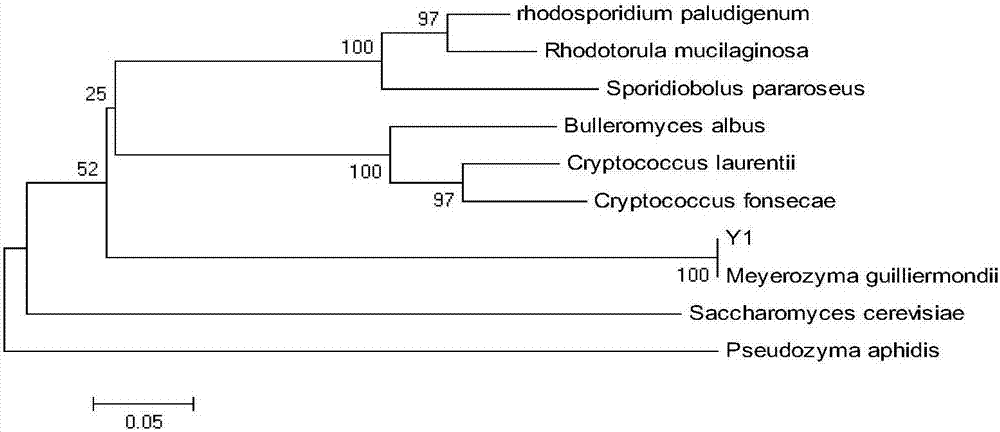Meyerozyma guilliermondii for controlling postharvest diseases of pome
A post-harvest disease and yeast technology, which is used in the preservation of fruits and vegetables, microorganism-based methods, and food preservation, etc., to achieve the effects of broad antibacterial spectrum, reduced losses, and significant economic and social benefits.
- Summary
- Abstract
- Description
- Claims
- Application Information
AI Technical Summary
Problems solved by technology
Method used
Image
Examples
Embodiment 1
[0023] Embodiment 1: the microbiological characteristics of Pichia pastoris (Meyerozyma guilliermondii) Y1 strain are as follows:
[0024] 1) Morphological features
[0025] (1) NYDA medium (beef extract 8g, yeast extract 5g, glucose 10g, agar 20g, 121°C moist heat sterilization for 20min) was cultured at 28°C for 48h, the colony was round, with smooth edges, moist and easy to provoke. The cells are oval in shape and scattered individually.
[0026] (2) After culturing in NYDB liquid medium for 24 hours, no mold was formed, and the bacterial solution was turbid with precipitation. Microscopically, the yeast cells were oval and budded.
[0027] 2) Molecular biological identification
[0028] Sequence analysis of the 5.8S rDNA-ITS region of the isolated and screened yeast strain Y1 was searched in GenBank and identified as Pichia guilliermondii. According to the retrieved homologous strains, the Mege5.1 program of DNAStar software was used to construct the biological evolutio...
Embodiment 2
[0030] Embodiment 2: Pichia mongolia Y1 safety experiment
[0031] 1) Experimental scheme
[0032] Preparation of Yeast Sludge and Total Determination
[0033] Pichia guilliermondii Y1 (Meyerozyma guilliermondii Y1) was inoculated in a Erlenmeyer flask containing NYDB medium, placed on a shaker, cultured at 28°C for 20 hours, and then centrifuged to obtain a fungus sludge. Gradiently dilute the bacteria slime with sterile water (10 -4 , 10 -5 , 10 -6 , 10 -7 ), and then pipette 100 μL of the diluted solution for uniform coating (NYDA), and count the experimental results after incubation. The whole experiment was performed in parallel twice. Each time the mice were gavaged with bacteria solution, they were diluted with fresh bacteria sludge.
[0034] The experimental subjects are ICR mice, provided by the Animal Experiment Center of Jiangsu University, the certificate number is NO.201613561, the license number is SCXK (Su) 2013-0011, and the implementation standard is GB...
Embodiment 3
[0040] Embodiment 3: the control effect of Pichia mongolica Y1 on Pythium penicillium
[0041] 1) Experimental scheme
[0042] Pichia mongolica Y1 was inoculated in a Erlenmeyer flask containing NYDB medium, cultured in a shaker at 180rpm and 28°C for 20h, centrifuged to obtain the bacteria, resuspended with sterile water and adjusted to a concentration of 1×10 8 cells / mL. Penicillium expansum (P.expansum) was cultured on PDA medium at 28°C for 7 days, the spores were washed with sterile water and the concentration of spores was adjusted to 1×10 5 spores / mL.
[0043] The fruits to be tested have been carefully selected, and the pears with uniform fruit, no scratches on the surface, no mechanical damage and no damage from diseases and insect pests are selected, and three uniform distributions are formed on the equator of the surface of the pome fruit with a burnt puncher. Wounds with consistent size and depth (5mm×3mm). Add 30 μL of the following treatment solution equally ...
PUM
| Property | Measurement | Unit |
|---|---|---|
| weight | aaaaa | aaaaa |
Abstract
Description
Claims
Application Information
 Login to View More
Login to View More - R&D
- Intellectual Property
- Life Sciences
- Materials
- Tech Scout
- Unparalleled Data Quality
- Higher Quality Content
- 60% Fewer Hallucinations
Browse by: Latest US Patents, China's latest patents, Technical Efficacy Thesaurus, Application Domain, Technology Topic, Popular Technical Reports.
© 2025 PatSnap. All rights reserved.Legal|Privacy policy|Modern Slavery Act Transparency Statement|Sitemap|About US| Contact US: help@patsnap.com



